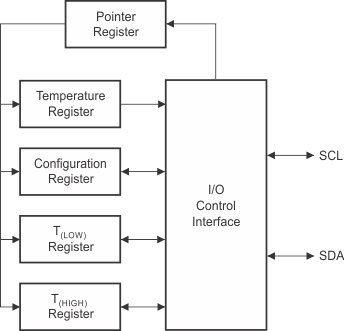SLOS887F September 2014 – June 2022 TMP112-Q1
PRODUCTION DATA
- 1 Features
- 2 Applications
- 3 Description
- 4 Revision History
- 5 Description (continued)
- 6 Pin Configuration and Functions
- 7 Specifications
-
8 Detailed Description
- 8.1 Overview
- 8.2 Functional Block Diagram
- 8.3 Feature Description
- 8.4 Device Functional Modes
- 8.5 Programming
- 9 Application and Implementation
- 10Power Supply Recommendations
- 11Layout
- 12Device and Documentation Support
- 13Mechanical, Packaging, and Orderable Information
Package Options
Mechanical Data (Package|Pins)
- DRL|6
Thermal pad, mechanical data (Package|Pins)
Orderable Information
8.5.1 Pointer Register
Figure 8-8 shows the internal register structure of the TMP112-Q1 device. The 8-bit pointer register of the device is used to address a given data register. The pointer register uses the two LSBs (see Table 8-12) to identify which of the data registers must respond to a read or write command. The power-up reset value of the P[1:0] byte is 00. By default, the TMP112-Q1 device reads the temperature on power up.
 Figure 8-8 Internal Register Structure
Figure 8-8 Internal Register StructureTable 8-6 lists the pointer address of the registers available in the TMP112-Q1 device.Table 8-7 lists the bits of the pointer register byte. During a write command, bytes P2 through P7 must always be 0.
Table 8-6 Pointer Addresses
| P1 | P0 | REGISTER |
|---|---|---|
| 0 | 0 | Temperature register (read only [R]) |
| 0 | 1 | Configuration register (read-write [R/W]) |
| 1 | 0 | T(LOW) register (R/W) |
| 1 | 1 | T(HIGH) register (R/W) |
Table 8-7 Pointer Register Byte
| P7 | P6 | P5 | P4 | P3 | P2 | P1 | P0 |
|---|---|---|---|---|---|---|---|
| 0 | 0 | 0 | 0 | 0 | 0 | Register Bits | |